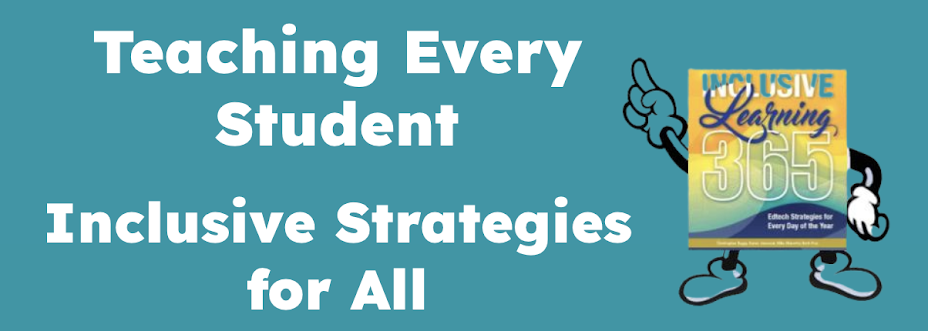 Too often we define students as learning disabled when, in fact, it is the instructional method that causes the disability. Now is the time to reframe how we view ability and disability.
Too often we define students as learning disabled when, in fact, it is the instructional method that causes the disability. Now is the time to reframe how we view ability and disability. The Future is in the Margins: The Role of Technology and Disability in Education Reform by Rose & Meyer (CAST) -
Differentiated use of media for instruction reveals that individuals who are defined as "learning disabled" within print-based learning environments are the not same individuals who are defined as "learning disabled" within video - or audio-based learning environments. Such revelations splinter the old categorical divisions between "disability" and "ability" and create new descriptors that explicitly recognize the interaction between student and environment in the definition of strengths.
Think about your instructional tools - are you offering a variety of methods to engage students, or are you methods causing frustration? Are you offering a variety of methods for students to demonstrate what they know? Encourage your students to demonstrate their strengths and abilities by varying the instructional methods and tools you use in your classroom. And their skills may surprise you!
I will never forget when my son was in 10th grade and I had a conference with his English teacher. I tried to explain his learning style and his challenges with print based materials and paper based assignments. She didn't seem to get it so I offered that he does best with multimedia and alternative methods to demonstrate what he has learned. He preferred projects since they tap into his strengths. Unfortunately, she still didn't get it and suggested, "Maybe we need to move him to a lower level in English." (Who has the disability in this scenario? The one who knows how he learns best or the one who can't see it?)
So, I repeat, too often we define students as learning disabled when, in fact, it is the instructional method that causes the disability.
What are you doing about that?
photo - http://www.psychiatry.emory.edu/PROGRAMS/GADrug/images/frustrated.jpg

6 comments:
Karen, I am so with you on this. To extend the topic (not to hijack your post), I'll just add that my Mohammad Ali: D- Student? Or F- School? post addresses the same problem, and has an excellent (and sometimes troubling) 80-comment discussion thread.
Arthus wrote a follow-up on Students 2.0 and his own blog also.
I'm not done with this subject either. The ease of audio and video input and output today make the text-biased assessments of yesteryear shamefully indefensible. We're ruining lives if we still follow them.
This is so important. The comment battle I had with the (thankfully) retired professor
http://speedchange.blogspot.com/2008/05/seven-simple-solutions-but-first-story.html
documents how destructive and prevalent attitudes of print privilege are. I am "illiterate" because I don't read "the right way."
Back in February I had a post that followed this issue all the way through the education system, because students from K-post-graduate are being stopped by people failing to embrace the possibilities of today's technology.
http://speedchange.blogspot.com/2008/02/medium-is-not-message.html
Karen-
Thanks for posting this article, and I agree with you. I've made a point of teaching my classes in such a way that I give all my students options. If you have a disability in the old system, there may be a way to put aside that "disability" if we personalize the learning experience for each student. If we can create alternative methods of both instruction and assessment then we can hopefully eliminate the things that have stopped certain students from learning in the past. My class is like a smörgåsbord, I tell the kids what Im looking for then give them 25 ways to prove to me they know it.
Great post! I can't wait to share this in my summer course (Nature and Characteristics of LD) with teachers. Maybe I'm weird, but I just don't understand why teachers think this is so hard. They want students to all be "cookie cutter" students and they never have and never will be as long as we are still human and not robots.
Karen, sorry for coming in to this so late. Great post. And, Pat, the reason teachers want "cookie cutter" students is because we have to give "cookie cutter" tests. As long as we are forced to give standard paper and pencil tests (sorry but testing mods do not include alternative methods for demonstrating knowledge) then we are forced to insist that children demonstrate understanding with paper and pencil. We must work on getting alternative assessments as a standard for measuring knowledge and understanding.
(I'll step off my soap box now.)
What am I doing about that in my grade 11/12 Learning Strategies Class that gives support to struggling/reluctant learners?
I introduced a class blog www.mrshartjes1.edublogs.org this semester and most kids loved it. Only one student hated computers.
There's so much available on line that the kids found engaging and that they could use to demonstrate their learning. I was impressed by what they could do, and so were they.
Post a Comment